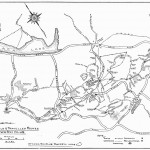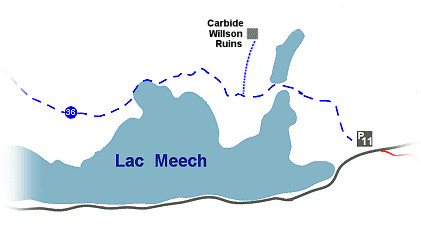This video being re-edited to accommodate copyright concerns.
It seems that one of the most photographed places in Gatineau Park is the Carbide Willson Ruins. They say that some people like to sunbathe nude there but that isn’t what most photos are about. I guess part of the charm is this mysterious structure in the middle of the wilderness.
Why’s it there?
 Carbide Willson was Thomas Leopold Willson. He was nicknamed Carbide Willson because he made a fortune after stumbling across the formula for calcium carbide.
Carbide Willson was Thomas Leopold Willson. He was nicknamed Carbide Willson because he made a fortune after stumbling across the formula for calcium carbide.
I’ll get to why calcium carbide might have made him rich in a moment, but first let me explain my “stumbling across” comment. He had invented an electric arc furnace and was trying to find a use for the thing. He figured he could produce aluminum from bauxite – fail. He tried producing metallic calcium – fail.
You can just see him in your mind’s eye poking whatever material he could lay his hands on into the furnace to try and turn out something useful. One of these tries combined coal tar with lime and produced a weird kind of mineral. These strange gravely bits started to bubble if you got them wet. Even weirder, the gas that was bubbling off them was freaking flammable.
 Willson had no idea what this stuff was that he’d produced and so started corresponding with world renowned scientists asking them if they knew. One of these was William Thomson at the University of Glasgow. William Thompson is better remembered as Lord Kelvin, the guy who came up with the idea that things could get so cold that there was an absolute zero degrees.
Willson had no idea what this stuff was that he’d produced and so started corresponding with world renowned scientists asking them if they knew. One of these was William Thomson at the University of Glasgow. William Thompson is better remembered as Lord Kelvin, the guy who came up with the idea that things could get so cold that there was an absolute zero degrees.
Anyway, our Carbide Willson eventually figured out with the help of these experts that the gravel he was producing was calcium carbide and that the gas that was bubbling off the calcium carbide was acetylene.
These days you might hear of acetylene torches that steel workers use to cut metal with those medieval looking wielder’s helmets on. Back before 1900 though, calcium carbide and acetylene had an entirely different use. Those were the days before electric light bulbs. This calcium carbide stuff was really handy for producing light and heat. All you needed to do was keep the stuff dry until you needed to use it.
 To use it you dumped it into a special type of canister with an upper and lower compartment. The lower compartment was half full of water and had a pipe running off it to the light fixtures and cooking ring. The calcium carbide gravel crowded down into a kind of funnel with a rubber valve mechanism on it. A few of the chunks of gravel would fall into the water and start to bubble and as the gas pressure increased it would close the rubber valve, preventing more calcium carbide from falling into the water. The lightly pressurized acetylene then flowed out to do its lighting and heating work, releasing pressure and allowing a few more chunks to restart the process.
To use it you dumped it into a special type of canister with an upper and lower compartment. The lower compartment was half full of water and had a pipe running off it to the light fixtures and cooking ring. The calcium carbide gravel crowded down into a kind of funnel with a rubber valve mechanism on it. A few of the chunks of gravel would fall into the water and start to bubble and as the gas pressure increased it would close the rubber valve, preventing more calcium carbide from falling into the water. The lightly pressurized acetylene then flowed out to do its lighting and heating work, releasing pressure and allowing a few more chunks to restart the process.
It was a beautiful system and since everyone had been reading by candle light and sooty coal oil lamps, everyone had to have it; and Thomas Leopold Willson controlled it all.
So that’s how he got rich and that’s why he was called Carbide Willson.
But that’s not what the Willson Ruin is about.
Having made a bundle lighting up the world he thought he had another bright idea; fertilizer. He wanted to corner the world market on chemical fertilizer. By this time he was living in Ottawa in grand style and like so many of the leading citizens wanted to have a cottage.
 Cottage might be a misnomer for a place that has eleven bedrooms and seven fireplaces and its own private telephone connection to the outside world. It was his house that later became the government conference centre where the Meech Lake Accord was dreamed up.
Cottage might be a misnomer for a place that has eleven bedrooms and seven fireplaces and its own private telephone connection to the outside world. It was his house that later became the government conference centre where the Meech Lake Accord was dreamed up.
Dispute his success Willson was a bit of a social klutz so he liked his isolated country estate and looked to the water flowing out of Meech Lake as a source of power for an experimental lab he wanted to set up to corner the fertilizer market. There was already a dam there that had once powered a sawmill but Willson had the means and liked to do things big so he rebuilt the dam in concrete and set up his little lab on a scale that looks to us, and must have looked to others at the time, like a full scale industrial installation. 
When I say he was a bit of a social klutz I mean that it never seemed to occur to him that it might annoy his neighbours on Meech Lake to have the lake level vary by six feet one way or another based on his need for generating power. There are reports of boathouses disappearing beneath the waves at one moment and then sometime later standing a good walk away from the water’s edge.
So the ruin that are the subject of so many pictures today had nothing to do with calcium carbide except for the fact it was financed by the stuff; and probably lighted by it.
Carbide Willson liked to do things big and he thought he had the means, but in fact he didn’t have the means. In pursuit of his fertilizer dream he was forced to sell his other assets and ended up ruined himself. He died in 1915 of a heart attack while trying to rebuild after bankruptcy.
Photo Credits and other links:
http://mcgoldrick.ca/xc-skiing/carbide-willson/
http://en.wikipedia.org/wiki/File:Willson_Mill_At_Gatineau_Park.jpg
http://rmcguirephoto.com/wordpress/2010/02/06/thomas-carbide-willson-ruins-gatineau-park-quebec/
http://www.flickr.com/photos/mikealex/3961625681/
http://www.flickriver.com/photos/mikealex/4229030545/
http://www.chesleyhouse.com/Books/MeechRuins.htm
http://www.panoramio.com/photo/1726259
http://www.flickriver.com/photos/richardmcguire/tags/creek/
http://www.trekearth.com/gallery/North_America/Canada/Central/Quebec/Gatineau/photo762514.htm
http://www.flickr.com/photos/mikealex/3981761969/
http://www.flickr.com/photos/mikealex/3982523338/
http://www.flickr.com/photos/digitalslg/4127217436/
http://www.uer.ca/locations/show.asp?locid=21491
http://www.onvertigo.ca/index.php?showimage=123
http://www.onvertigo.ca/archives.php
http://www.flickr.com/photos/s_and_d/2919817761/
http://www.flickr.com/photos/rocurti/4018787034/
http://www.flickr.com/photos/digitalslg/4534788388/
http://www.flickr.com/photos/inottawa/3437647900/
http://www.flickr.com/photos/aylmerqc/266595445/
http://www.flickr.com/photos/kadacat/1508366545/
http://www.flickr.com/photos/aylmerqc/1538783402/
http://www.flickr.com/photos/kadacat/1555694754/
http://www.flickr.com/photos/haofeng/3993881961/
http://www.flickr.com/photos/haofeng/3949490078/
http://www.flickr.com/photos/kadacat/1573770616/
http://www.flickr.com/photos/kadacat/1519733198/
http://www.flickr.com/photos/mikealex/4534127953/
http://www.flickr.com/photos/mikealex/4229030545/



Nicely done. The ruins are one of my favourite spots in the Ottawa area to photograph. I’ve been going there for over 10 years now, and it never gets dull.
Thank-you for including the photo credits at the end of the article, it is appreciated!
So, for someone who has never been there, is there a map or indications to find it?
Thanks!
From here http://mcgoldrick.ca/xc-skiing/carbide-willson/ a map

Duh, thank you! I clicked a bunch of links from the post randomly, but I guess I skipped the first one! I’ll definitely visit the place with my daughter soon!
Leave your daughter at home, Pat. Take her during the winter time only. Don’t take my word, even the NCC omits the site from their summer maps.
Saguenay, Churchill Falls, Superphospate, New York City…
It’s kid friendly enough. In all my trips there, I’ve only seen nudists there a handful of times, and they tend to stay up above the dam, away from the main ruins. I see families with kids there far more often than I see nudists.